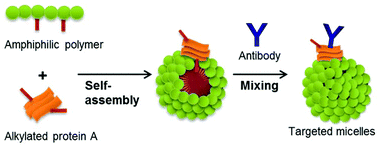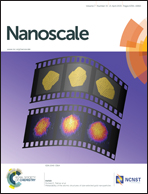Bacteria-mimicking nanoparticle surface functionalization with targeting motifs†
Abstract
In recent years, surface modification of nanocarriers with targeting motifs has been explored to modulate delivery of various diagnostic, sensing and therapeutic molecular cargo to desired sites of interest in in vitro bioengineering platforms and in vivo pathologic tissue. However, most surface functionalization approaches are often plagued by complex chemical modifications and effortful purifications. To resolve such challenges, this study demonstrates a unique method to immobilize antibodies that can act as targeting motifs on the surfaces of nanocarriers, inspired by a process that bacteria use for immobilization of the host's antibodies. We hypothesized that alkylated Staphylococcus aureus protein A (SpA) would self-assemble with micelles and subsequently induce stable coupling of antibodies to the micelles. We examined this hypothesis by using poly(2-hydroxyethyl-co-octadecyl aspartamide) (PHEA-g-C18) as a model polymer to form micelles. The self-assembly between the micelles and alkylated SpA became more thermodynamically favorable by increasing the degree of substitution of octadecyl chains to PHEA-g-C18, due to a positive entropy change. Lastly, the mixing of SpA-PA-coupled micelles with antibodies resulted in the coating of micelles with antibodies, as confirmed with a fluorescence resonance energy transfer (FRET) assay. The micelles coated with antibodies to VCAM-1 or integrin αv displayed a higher binding affinity to substrates coated with VCAM-1 and integrin αvβ3, respectively, than other controls, as evaluated with surface plasmon resonance (SPR) spectroscopy and a circulation-simulating flow chamber. We envisage that this bacteria-inspired protein immobilization approach will be useful to improve the quality of targeted delivery of nanoparticles, and can be extended to modify the surface of a wide array of nanocarriers.



 Please wait while we load your content...
Please wait while we load your content...